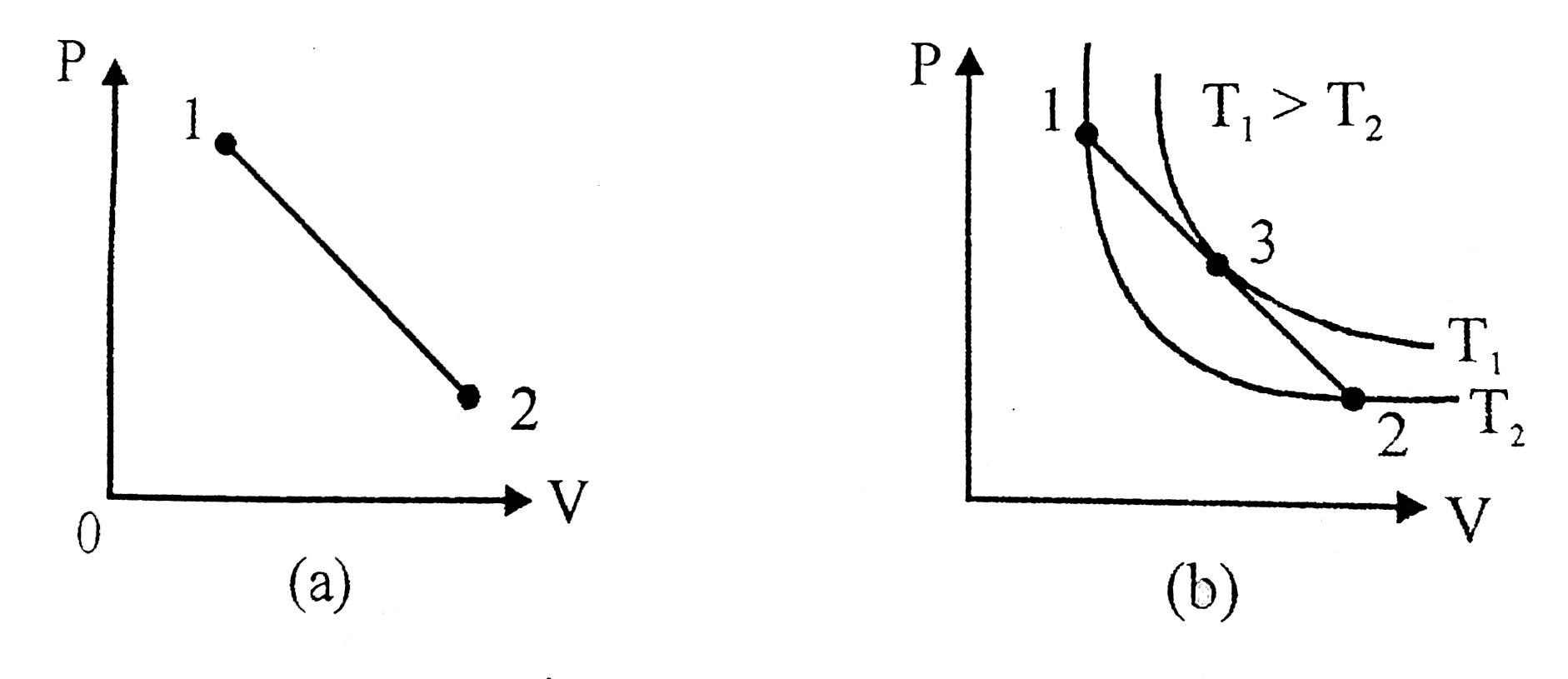X and Y are two cylinders, fitted with frictionless pistons. Both of them contain equal amounts of oxygen at 200K. Equal amount of heat is given to the gas in each cylinder. However, the piston of A is fixed while that of B is movable. What is the rise in temperature of the gas in B, if the rise in temperature of A is 42 K ?
50 K
40 K
30 K
25 K
The correct Answer is:C
The piston of A is fixed. Hence the gas in it is heated at constant volume.
∴ Heat absorbed by O2 in A is Q1=nCV(dT1)
and since the piston of B is movable, the gas in B is heated at constant pressure (atmospheric pressure) and the heat absorbed by oxygen in B is Q2=nCP(dT2)
For a diatomic gas like O2,CV=52RandCP=72R
and since Q1=Q2anddT1=42
∴nCV(dT1)=nCP(dT2)
∴52R×42=72R(dT2)
∴7(dT2)=210 ∴(dT2)=30K
∴ Rise in temperature of the gas in B = 30 K
Topper's Solved these Questions
- KINETIC THEORY OF GASES ,THERMODYNAMICS AND RADIATIONBOOK - MARVEL PUBLICATIONCHAPTER - KINETIC THEORY OF GASES ,THERMODYNAMICS AND RADIATIONEXERCISE - TEST YOUR GRASP - 9
30 Videos
- INTERFERENCE AND DIFFRACTIONBOOK - MARVEL PUBLICATIONCHAPTER - INTERFERENCE AND DIFFRACTIONEXERCISE - TEST YOUR GRASP
20 Videos
- MAGNETIC EFFECTS OF ELECTRIC CURRENTBOOK - MARVEL PUBLICATIONCHAPTER - MAGNETIC EFFECTS OF ELECTRIC CURRENTEXERCISE - MCQ
195 Videos
Similar Questions
Two cylinders of equal size are filled with equal amount of ideal diatomic gas at room temperature. Both the cylinders are fitted with pistons. In cylinder A the piston is free to move, while in cylinder B the piston is fixed. When same amount of heat is added to both the cylinders, the temperature of the gas in cylinder A raises by 20 K. What will be the rise in temperature of the gas in cylinder B?
View SolutionTwo cylinderical bodies 'A' and 'B' have their radii in the ratio of 1:2 and their lengths are in the ratio of 3:2. When equal amount of heat energy is supplied to them, the rise in the temperature of A is found to be double the rise in temperature of B. Determine the ratio of their specific heat capacity. The ratio of density of A and B is 3:1
View Solution
Knowledge Check
Two cylinders A and B fitted with pistons contain equal amounts of an ideal diatomic gas at 300K. The piston of A is free to move, while that B is held fixed. The same amount of heat is given to the gas in each cylinder. If the rise in temperature of the gas in A is 30K, then the rise in temperature of the gas in B is
A30KB18KC50KD42KTwo cylinders A and B fitted with pistons contain equal amounts of an ideal diatomic gas at 300 K. The piston of A is free to move, while that of B is held fixed. The same amount of heat is given to the gas ineach cylinder. If the rise in temperature of the gas in A to 30 K, then the rise in temperature of the gas in B is
A30 KB18 KC50 KD42 KA cylinder of fixed capacity (of 44.8 L) contains 2 moles of helium gas at STP .What is the amount of heat needed to raise the temperature of the gas in the cylinder by 20∘C ? (UseR=8.31Jmol−1K−1)
A496JB495JC502JD499J
Two cylinderical bodies 'A' and 'B' have their radii in the ratio of 1:2 and their lengths are in the ratio of 3:2. When equal amount of heat energy is supplied to them, the rise in the temperature of A is found to be double the rise in temperature of B. Determine the ratio of their specific heat capacity. The ratio of density of A and B is 3:1
View SolutionEqual masses of oxygen and helium gases are supplied equal amount of heat. Which gas will undergo a greater temperature rise and why?
View SolutionA gas is enclosed in a cylinder with a freely movable piston. The load on the piston is gradually decreased. The temperature of the gas can be changed by placing the cylinder in hot and cold heat reservoirs. The figure shown P−Vgraph of such a cylinder. What intermediate can be drawn the nature of change in the temperature of the gas ?
 " "
" " 
View SolutionA cylinder contains 3 moles of oxygen at a temperature of 27∘C. The cylinder is provided with a frictionless piston which maintains a constant pressure of 1 atm on the gas. The gas is heated until its temperature rises to 127∘C.
a. How much work is done by the gas in the process ?
b. What is the change in the internal energy of the gas ?
c. How much heat was supplied to the gas ?
For oxygen CP=7.03calmol−1.∘C−1.
View SolutionTwo identical vessels A & B contain equal amount of ideal monoatomic gas. The piston of A is fixed but that of B is free. Same amount of heat is absorbe3d by A & B 's internal energy increases by 100 J the change in internal energy of A is

View Solution
